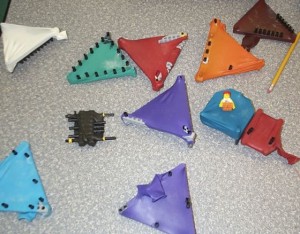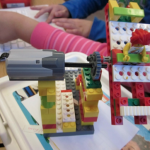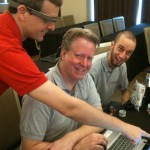The following four curricula are designed to introduce students (in Grades 3 to 5) to various science concepts through design-based LEGO projects. The first several lessons of each unit engage students in scientific explorations sometimes using the LEGO tool-set as a resource. The students are then charged with an open-ended design challenge where they use the science they learned alongside the engineering design process to design and build LEGO creations that meet criteria that the students can observe and test.
Intro Unit
This series of introductory lessons should be completed before beginning a Science Through LEGO Engineering curriculum unit. Students will first be introduced to the engineering design process and its results in the world around us. They will also learn the names and uses of the LEGO pieces commonly used for LEGO engineering challenges. Then, students will practice using different methods of LEGO construction. This introductory curriculum consists of two lessons that are approximately 60 minutes in length.
- Download Introduction Unit (PDF, 2.3MB)
Design a Musical Instrument: The Science of Sound
This curriculum engages students in explorations about the science of sound, which culminates with students designing and building a musical instrument that plays at least three different pitches. Students will learn about the relationship between vibrations and sound and what pitch is and how it can be changed, and then implement these concepts with some creative LEGO Engineering. The curriculum consists of 9 lessons that are approximately 60 minutes in length.
- Download The Science of Sound (PDF, 3.8MB) including:
- Teacher’s guide
- Student handouts
- Supplemental resources
- Download The Science of Sound additional files (ZIP, 3.9MB) including:
- Engineering Design Process poster
- WAV files of instrument sounds
- NXT-G programs
- Sample classroom posters
Design a Model House: The Properties of Materials
This curriculum engages students in explorations about the science behind the properties of materials, which culminates with students designing and building a model house. Students will learn about material properties such as strength, flexibility, insulating ability, sound absorption ability, waterproofing, color, and reflectivity, and then implement what they learn to create a model house that meets the engineering requirements (quiet, waterproof, comfortable, and stable). The curriculum consists of 10 lessons that are approximately 60 minutes in length.
- Download The Properties of Materials (PDF, 2.7MB) including:
- Teacher’s guide
- Student handouts
- Supplemental resources
- Download The Properties of Materials additional files (ZIP, 3.8MB) including:
- Engineering Design Process poster
- NXT-G programs
- Sample classroom posters
Design an Animal Model: Animal Studies
 This curriculum engages students in explorations about the physical and behavioral characteristics of the major groups of animals (fish, amphibians, reptiles, mammals, crustaceans, insects, birds), which culminates with students designing and building a fictional animal that displays physical and behavioral characteristics adaptable to a rainforest ecosystem. The curriculum consists of 11 lessons that are approximately 60 minutes in length.
This curriculum engages students in explorations about the physical and behavioral characteristics of the major groups of animals (fish, amphibians, reptiles, mammals, crustaceans, insects, birds), which culminates with students designing and building a fictional animal that displays physical and behavioral characteristics adaptable to a rainforest ecosystem. The curriculum consists of 11 lessons that are approximately 60 minutes in length.
- Download Animal Studies (PDF, 4.2MB) including:
- Teacher’s guide
- Student handouts
- Supplemental resources
- Download Animal Studies additional files (ZIP, 15MB) including:
- Engineering Design Process poster
- NXT-G programs
- Animal and rainforest images
Design a People Mover: Simple Machines
 This curriculum engages students in explorations about the science behind simple machines, which culminates with students designing and building a people mover. Students will learn about levers, wheel-and-axles, inclined planes, wedges, screws, pulleys, and gears, and then implement these with some creative LEGO Engineering. The curriculum consists of 11 lessons that are approximately 60 minutes in length.
This curriculum engages students in explorations about the science behind simple machines, which culminates with students designing and building a people mover. Students will learn about levers, wheel-and-axles, inclined planes, wedges, screws, pulleys, and gears, and then implement these with some creative LEGO Engineering. The curriculum consists of 11 lessons that are approximately 60 minutes in length.
- Download Simple Machines (PDF, 4.3MB) including:
- Teacher’s guide
- Student handouts
- Supplemental resources
- Download Simple Machines additional files (ZIP, 1.5MB) including:
- Engineering Design Process poster
- Blank Trade-Off Chart
- Completed Trade-Off Chart
The preparation of this curriculum was partially supported by grant DRL-0423059 from the National Science Foundation. Grantees undertaking such projects are encouraged to express freely their professional judgement. This curriculum, therefore, does not necessarily represent the position or policies of the National Science Foundation.
CEEO
Latest posts by CEEO (see all)
- Chair for Mr Bear - 21 August 2020
- Assistive Technology: Making Lives Easier - 20 August 2020
- Sturdy Tower - 14 June 2020
- Going the Distance - 21 May 2020
- GPS accuracy testing with LEGO bricks - 10 September 2015




